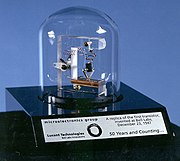BRIEF OF TASK:
COMPONENTS LIST:
12V Battery
2x capacitors
7x resistors R2 R3 R4 = 1K R5 = 380ohms R6 = 10K R7 = 270 Ohms R8 = 470 Ohms
3x LED. (green, yellow,red)
1x 9.1V Zener diode
3x diodes
Op Amp LM324
CALCULATIONS:
For resistors 2,3,4
Voltage supply is 12V, LED has a voltage of 1.8V and 9.5mA needed for it to light, diode uses up 0.6V. With these numbers, ohms law can be applied to calculate resistors 2,3,4.
OHMS LAW.
R2= V/A=R 12-0.6-1.8= 9.6V
A=0.0095A (9.5mA)
R= 9.6/0.095=1010.52 (figure rounds off to be 1000/1K.)
R3=V/A=R 12-0.6-0.6-1.8= 9V
A=0.0095A (9.5mA)
R=9/0.0095= 947.36 (figure rounds off to be 950 Ohms and resistor that will be used is also 1K)
R4= V/A=R 12-0.6-1.8=9.6V
A= 0.0095A(9.5mA)
R=9.6/0.0095=1010.52 (figure rounds off to be 1000 Ohms/1K.)
Resistors 5,7,8 are calculated as follows:
12V, 0.6 (diode), 9.1V (Zener diode), 12-0.6=11.4V 11.4-9.1=2.3Vd across R5
Current is 0.0056A (56mA)
R5=V/I=R 2.3/0.0056= 410.71 ( rounds off to be 410 Ohms used instead will be 390 ohms for R5)
R6=10K (10000 Ohms) Since resistor is given, voltage needs to be calculated also current.
Voltage is from Zener diode(9.1) and the point of available
voltage(0.63V)= 9.1-0.63=8.47V
Ohms law=R/V=I 10.000/8.47= I =0.000847A
0.000847 is the current flowing through the circuit after R6 and which
will be through this side of circuit for it in series.
R7=R=V/I=R Available voltage is 0.23V, I=0.000847A
0.23/0.000847=271.54( rounds off to be 270 Ohms)
R8=R=V/I=R Available voltage is 0.63V and 0.23V, I=0.000847A
0.63-0.23=0.4V/0.000847A=472.25(rounds off to be 470 Ohms)
VALUES OF RESISTORS:
R2=1K R3=1K R4=1K R5=390 Ohms R6=10K R7=270 Ohms R8=470 Ohms
TECHNICAL EXPLANATION:
When this unit is installed onto vehicle, my green LED would light showing that voltage is flowing through LED into terminal 14 and being grounded by op amp. This is because terminal 13 has a voltage of 0.23V and terminal 12 which would be connected to oxygen sensor and show voltage but this would be lower than that of terminal 13 therefore op amp would ground the circuit and light green. When my yellow LED lights, this shows that voltage is flowing through diode, LED into terminal 8 and is grounded by op amp. this is because when the o2 sensor get to operating point, at terminal 9 is now at a higher voltage than terminal 10 which is 0.23V, therefore op amp would ground circuit and light yellow. When red LED lights, this show voltage is flowing through diode, LED into terminal 8 and grounded by op amp, this shows that terminal 6 which has a voltage of 0.63V will have a higher voltage than terminal 5 which has voltage of 0.23V, as op amp is lighting red LED, yellow will turn off because terminal 2 of op amp is also reading 0.63V voltage than that of terminal 3 reading 0.23V, terminal 1 outputs positive which flows through diode to LED causing LED to have positive on both sides turning it off. When vehicle was cruising, LEDs would all light one at a time from green,yellow,red and back indicating that air and fuel mixture is ideal which 14.7 (lambda) . When vehicle has pedal to the floor then it would light red indicating a rich mixture of air and fuel. When is decelerating then green LED would light indicating a lean mixture of air and fuel.
FAULT FINDINGS
When a class mate finished her circuit, she had a diode that had a voltage drop of 10.5V. This wasn't right because this diode has a voltage drop of 0.6. This was causing her yellow LED to light when it should light green. She then replaced the diode and circuit work properly.
REFLECTIONS:
I'm now understanding have to identify what part of a compound circuit is parallel and series. I can take a part number of a op amp and surf the internet for wire diagrams. I can calculate what a resistor value would need to be for components to operate safely. I understand and know to how use op amps, transistors. The difference between a op amps, BJT, MOSFET. How to calculate to make a voltage divider circuit. How to read colour bands on resistors. I know how to convert mA to A or mV to V or uf to F. Before this course I didn't hear of or know ohms or kerrshoff law now I use it for all calculations needed.
We were given a schematic diagram for a oxygen sensor circuit. Task is to find out values of the resistors needed within the circuit so components within circuit can operate safely. Voltage is also needed to be calculated to figure out what's available throughout the circuit.
COMPONENTS LIST:
12V Battery
2x capacitors
7x resistors R2 R3 R4 = 1K R5 = 380ohms R6 = 10K R7 = 270 Ohms R8 = 470 Ohms
3x LED. (green, yellow,red)
1x 9.1V Zener diode
3x diodes
Op Amp LM324
CALCULATIONS:
For resistors 2,3,4
Voltage supply is 12V, LED has a voltage of 1.8V and 9.5mA needed for it to light, diode uses up 0.6V. With these numbers, ohms law can be applied to calculate resistors 2,3,4.
OHMS LAW.
R2= V/A=R 12-0.6-1.8= 9.6V
A=0.0095A (9.5mA)
R= 9.6/0.095=1010.52 (figure rounds off to be 1000/1K.)
R3=V/A=R 12-0.6-0.6-1.8= 9V
A=0.0095A (9.5mA)
R=9/0.0095= 947.36 (figure rounds off to be 950 Ohms and resistor that will be used is also 1K)
R4= V/A=R 12-0.6-1.8=9.6V
A= 0.0095A(9.5mA)
R=9.6/0.0095=1010.52 (figure rounds off to be 1000 Ohms/1K.)
Resistors 5,7,8 are calculated as follows:
12V, 0.6 (diode), 9.1V (Zener diode), 12-0.6=11.4V 11.4-9.1=2.3Vd across R5
Current is 0.0056A (56mA)
R5=V/I=R 2.3/0.0056= 410.71 ( rounds off to be 410 Ohms used instead will be 390 ohms for R5)
R6=10K (10000 Ohms) Since resistor is given, voltage needs to be calculated also current.
Voltage is from Zener diode(9.1) and the point of available
voltage(0.63V)= 9.1-0.63=8.47V
Ohms law=R/V=I 10.000/8.47= I =0.000847A
0.000847 is the current flowing through the circuit after R6 and which
will be through this side of circuit for it in series.
R7=R=V/I=R Available voltage is 0.23V, I=0.000847A
0.23/0.000847=271.54( rounds off to be 270 Ohms)
R8=R=V/I=R Available voltage is 0.63V and 0.23V, I=0.000847A
0.63-0.23=0.4V/0.000847A=472.25(rounds off to be 470 Ohms)
VALUES OF RESISTORS:
R2=1K R3=1K R4=1K R5=390 Ohms R6=10K R7=270 Ohms R8=470 Ohms
 |
| http://www.chinaicmart.com/uploadfile/ic-data/200932684830264.jpg |
When this unit is installed onto vehicle, my green LED would light showing that voltage is flowing through LED into terminal 14 and being grounded by op amp. This is because terminal 13 has a voltage of 0.23V and terminal 12 which would be connected to oxygen sensor and show voltage but this would be lower than that of terminal 13 therefore op amp would ground the circuit and light green. When my yellow LED lights, this shows that voltage is flowing through diode, LED into terminal 8 and is grounded by op amp. this is because when the o2 sensor get to operating point, at terminal 9 is now at a higher voltage than terminal 10 which is 0.23V, therefore op amp would ground circuit and light yellow. When red LED lights, this show voltage is flowing through diode, LED into terminal 8 and grounded by op amp, this shows that terminal 6 which has a voltage of 0.63V will have a higher voltage than terminal 5 which has voltage of 0.23V, as op amp is lighting red LED, yellow will turn off because terminal 2 of op amp is also reading 0.63V voltage than that of terminal 3 reading 0.23V, terminal 1 outputs positive which flows through diode to LED causing LED to have positive on both sides turning it off. When vehicle was cruising, LEDs would all light one at a time from green,yellow,red and back indicating that air and fuel mixture is ideal which 14.7 (lambda) . When vehicle has pedal to the floor then it would light red indicating a rich mixture of air and fuel. When is decelerating then green LED would light indicating a lean mixture of air and fuel.
FAULT FINDINGS
When a class mate finished her circuit, she had a diode that had a voltage drop of 10.5V. This wasn't right because this diode has a voltage drop of 0.6. This was causing her yellow LED to light when it should light green. She then replaced the diode and circuit work properly.
REFLECTIONS:
I'm now understanding have to identify what part of a compound circuit is parallel and series. I can take a part number of a op amp and surf the internet for wire diagrams. I can calculate what a resistor value would need to be for components to operate safely. I understand and know to how use op amps, transistors. The difference between a op amps, BJT, MOSFET. How to calculate to make a voltage divider circuit. How to read colour bands on resistors. I know how to convert mA to A or mV to V or uf to F. Before this course I didn't hear of or know ohms or kerrshoff law now I use it for all calculations needed.











